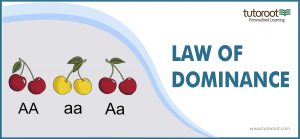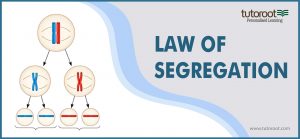Complete Guide to Law of Segregation and Law of Dominance
In order to transfer various genetic characteristics or traits, from parents to offspring, the law of dominance and law of segregation play an important role. However, not many students generally have a deeper understanding of these laws and their importance in species growth and evolution. In this article, we have put together a complete guide to the Law of Segregation and the Law of Dominance, along with their characteristics, importance, and many more. Before, we also touched on laws of inheritance, besides understanding aspects such as the Monohybrid Cross.

Mendel’s Laws of Inheritance
Before we delve into the Law of Segregation and Law of Dominance, you must know that the Founder of Genetics, Gregor Johann Mendel introduced Mendel’s Laws of Inheritance, back in the year 1860. These laws include,
- Laws of Dominance.
- Law of Segregation.
- Law of Independent Assortment.
Gregor Mendel experimented on various types of pea plants, to identify how the pattern of inheritance is transferred from one generation to another.
Through immense experimentation on the pea plants, Mendel read the pattern of inheritance from one generation to another. These studies form the most critical base for the discovery of three laws of inheritance that are famously referred to as Mendel’s Laws of Inheritance.
What is the Law of Dominance?
This law states that “When the parents with pure, contrasting traits are crossed together, only one form of trait appears in the next generation. The hybrid offspring will only exhibit the dominant trait of Phenotype”.

Law of Dominance
For instance, each character in a species is controlled by a distinct unit called a factor, which decides whether one trait is dominant or not in a particular generation of species. For example, when two contrasting traits are taken from each parental character, then only one trait is expressed in the First Generation, while there is a chance that two traits are expressed in the second generation.
And as you can observe in F1 or first generation only one trait will dominate the other trait, which is expressed in the Law of Dominance in detail. The inheritance of traits in the first and second generations is defined by the ratio of 3:1.
What is the Law of Segregation?
The Law of Segregation explains that “When an organism starts making gametes, it then integrates each of these gametes, with a unique of different gene copy, that has been selected randomly”. So according to this law, each gamete formed in the species consists of only one random allele. However, to understand Mendel’s law of segregation, you must keep in mind the four concepts or aspects such as,

Law of Segregation
- Alleles inside each gene are of different types.
- Each and every organism naturally inherits two alleles that are allocated to a single character or trait.
- And as said above, the allele pairs are usually different, as one can be recessive, while the other can be dominant.
- The gametes are formed through a meiosis process, and this results in the separation of allelic pairs.
What is a Monohybrid Cross?
A monohybrid cross is defined as a cross between the two monohybrid traits (TT and tt). Here plants that have the same characters, but differ in only one character were crossed.
Under monohybrid cross, Mendel experimented with a pea plant pair in which the two have contrasting traits, i.e., one was tall and the other was dwarf. There was cross-pollination of tall and dwarf plants that led to having tall plants as the offspring and were referred to as F1 progeny. This trait in the phenotype is seen as the dominant trait while the other dormant ones becomes the recessive trait.
Mendel sustained the experimentation with the self-pollination of F1 progeny plants. This led to interesting outcomes, both tall and short plants, and a 3:1 ratio, thus resulting in the law of segregation.
Thus, in the case of the Law of Dominance, we learn that in a monohybrid cross, between a pair of opposing traits, the character of one parent will be expressed in the F1 generation whereas the characters of both parents will be manifested in the F2 generation. This is seen in a ratio of 3:1.
In summary, the law of dominance with respect to monohybrid cross shows recessive traits being dominated or covered by the dominant trait. As one delves deeper into Mendel’s Laws of Inheritance, the monohybrid cross becomes a crucial perspective for deeper understanding.
Conclusion
The above article provides a comprehensive description of Mendel’s Law of Segregation Example and Mendel’s Law of Dominance. In this, we attempted to capture the Laws of Inheritance, along with the understanding of the monohybrid cross. If you want more efficient and personalized coaching in the tougher topics or chapters in Biology, then we suggest considering Online Interactive Classes. Currently, the Tutoroot platform offers an Online Home Tutor program, for cost-effective prices with many amazing benefits. If you are interested, go visit the official website.
Frequently Asked Questions
What is Monohybrid Cross? Define Monohybrid Cross
A monohybrid cross is defined as a cross between the two monohybrid traits (TT and tt). Here plants that have the same characters, but differ in only one character were crossed.
Under monohybrid cross, Mendel experimented with a pea plant pair in which the two have contrasting traits, i.e., one was tall and the other was dwarf. There was cross-pollination of tall and dwarf plants that led to having tall plants as the offspring and were referred to as F1 progeny. This trait in the phenotype is seen as the dominant trait while the other dormant ones becomes the recessive trait.
Give Law of Segregation Examples
Mendel sustained the experimentation with the self-pollination of F1 progeny plants. This led to interesting outcomes, both tall and short plants, and a 3:1 ratio, thus resulting in the law of segregation.
Define Law of Dominance
This law states that “When the parents with pure, contrasting traits are crossed together, only one form of trait appears in the next generation. The hybrid offspring will only exhibit the dominant trait of Phenotype”.
For instance, each character in a species is controlled by a distinct unit called a factor, which decides whether one trait is dominant or not in a particular generation of species. For example, when two contrasting traits are taken from each parental character, then only one trait is expressed in the First Generation, while there is a chance that two traits are expressed in the second generation.
Give Examples of Laws of Dominance
Pea plants pair in which the two have contrasting traits, i.e., one was tall and the other was dwarf. There was cross-pollination of tall and dwarf plants that led to having tall plants as the offspring and were referred to as F1 progeny. This trait in the phenotype is seen as the dominant trait while the other dormant ones becomes the recessive trait.
What can we observe in order to visualize Mendel’s law of segregation?
To visualize Mendel’s Law of Segregation, you can observe individual Homologous chromosomes. This chromosome includes individual alleles for each gene.
